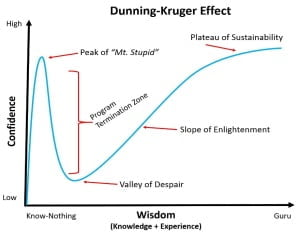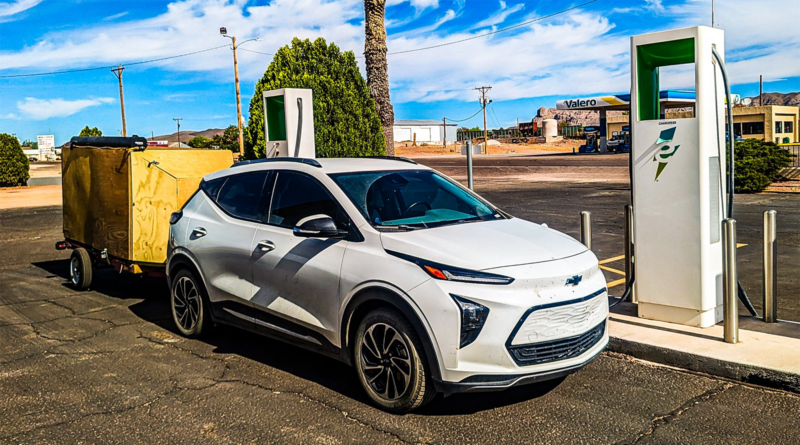The “Peak of Mount Stupid” — What I Learned Pulling A Trailer Across Texas With My Bolt EUV

Last Updated on: 23rd May 2024, 10:18 am
The journey to gaining new knowledge and skills isn’t a steady climb. Why? Because it’s easy to feel confident too early. When you go from knowing basically nothing about something and then learn a little bit, that little bit represents an infinite increase. Looking back at where you once were can make you feel like you are a quick study and know a LOT, but you don’t know what you don’t know.
This idea, a modification of the Dunning-Kruger effect, has become a meme, with various versions of this graphic floating around the internet:

My “Peak of Mount Stupid”
When I first got my little trailer last year and started building on it, I had a pretty solid plan. Using A Better Route Planner, I drove the trailer on a 50-mile drive while recording data to see what kind of energy it consumed (2.57 miles/kWh) for future trip planning. With that data in hand, the software could take care of the rest.
When I made some additions to the trailer this year and added a more aerodynamic front box, I took it on a short drive and it showed a little less energy usage, which led me to believe that my old energy estimate would make a good, safe planning figure!
Leaving El Paso with the trailer, things went pretty well, but only for about 60 miles. Interstate 10 follows the Rio Grande for about that distance, but then the highway leaves the valley to head into the rest of West Texas. At that point, there’s a steep climb out of the valley, up onto the mesa, and then into a pass next to the Quitman Mountains. The road goes up over 1,000 feet in only a few miles.
As I climbed away from the river, I noticed that the power levels were dropping a lot faster than ABRP had predicted. I would have continued monitoring with ABRP, but a couple of days earlier, it stopped supporting my OBD Bluetooth dongle, so I had to rely on the guess-o-meter to compensate instead. First, I dropped onto a frontage road. Then, I slowed down a little more. Then, I stayed on the frontage road for most of the way from Sierra Blanca to Van Horn (the next charger).
During the last ten miles, I had to go back on the interstate, but by then the car was already lowering available power. With my hazards flashing and trucks blowing by me on a mountainous stretch of road just before Van Horn, I struggled along at 45 MPH until the downhill came. Using a lot of inertia, I coasted onto the frontage road using only a handful of kilowatts of power and rolled into the Days Inn parking lot with the final “bar” of battery flashing and the guess-o-meter only showing “Low.”
At this point, I assumed that I had gotten a good estimate for the flats, but that I needed to add an extra 15% or so on stretches with big climbs. This worked for two more stretches between charging stops from Van Horn to Pecos and from Pecos to Midland.
The Valley of Despair
When I was approaching the next charging stop in Sweetwater, I noticed that I was running a little low on power again. So, like I did on the climb out of El Paso, I slowed down a bit. Then, I slowed down a bit more as I noticed the miles remaining on Waze staying above the estimated miles left. The power reduced, and then it reduced a bit more, only giving me 4 kW. As I climbed the last overpass before my exit, the last bar on the guess-o-meter stopped flashing and the car notified me that it was out of juice completely.
Fortunately, I was still going about 50 MPH, and it was all downhill to the offramp, which was also downhill. After exiting the highway, I used the remaining kinetic energy to coast into a parking lot and park next to a cell phone store, right in front of a plug. The people inside the store said I was welcome to plug into it, but the plug didn’t work, leaving me stranded about a half mile from Walmart and Electrify America.
What saved me from having to get towed to the station and leave my trailer in a strange parking lot was that I had a Jackery 3000 Pro in the trailer that had been charging from the Bolt during charging stops. With 3 kWh of storage, I was able to add about 0.7 kWh to the car in 30 minutes as I went to a nearby gas station to use the restroom and grab a drink.
I got to the station, but felt pretty depressed about things. I thought I knew what I was doing, but it turned out that I didn’t. So, I took a break while the car charged and decided to work on dinner using the little kitchen I had built into the trailer. I also made some minor repairs to the trailer (which had also proven to me that I knew less than I thought).
The Slope of Enlightenment
When I was done eating my pizza and my humble pie, I decided to rethink things. Instead of worrying about the 2.57 miles/kWh estimate that I wish the Bolt had pulling the small trailer, I decided to go back to basics. I had been tracking actual consumed energy for the past 450 miles going 65–70 mph, and it showed 2.1 miles/kWh. Punching that reference figure in didn’t quite make ABRP’s consumption match my actual consumed energy for the past few stops, so I lowered it some more. And lowered it a little more and raised it a bit until ABRP produced results that matched past stretches.
The final figure came out to about 1.95 miles/kWh. It’s a disappointing figure, but it proved accurate over the next few hundred miles and then started leaving me with extra energy at some stops.
More Charging Stops Are Definitely Needed
When the software was accurate, it left me feeling pretty confident about EV travel. I could go anywhere! But, when my tool stopped working, I had to go back to what new EV drivers often deal with. Instead of having a plan, I longed for the days when I could drive until the needle got closer to L and then go to the next gas station.
During the two worst charging stops, I passed a number of gas stations. Climbing from the Rio Grande to Sierra Blanca, I passed the Traveling Tiger truck stop. That sure would have made a nice place for an EV charger! Later, in Texas, I passed rural gas stations (the few that are left) and wished I could stop for a charge about then.
Granted, towing with a Bolt EUV is a horrid edge case, but it shows that there’s a lot more work to be done on EV charging infrastructure. There need to be a LOT more stations and a lot more stalls at them, and they need to almost all work about perfectly for the average person to be more comfortable with EVs. So, we have a lot of work to do!
Featured image by Jennifer Sensiba.

Sign up for CleanTechnica's Weekly Substack for Zach and Scott's in-depth analyses and high level summaries, sign up for our daily newsletter, and follow us on Google News!
Whether you have solar power or not, please complete our latest solar power survey.
Have a tip for CleanTechnica? Want to advertise? Want to suggest a guest for our CleanTech Talk podcast? Contact us here.
Sign up for our daily newsletter for 15 new cleantech stories a day. Or sign up for our weekly one on top stories of the week if daily is too frequent.
CleanTechnica uses affiliate links. See our policy here.
CleanTechnica's Comment Policy

